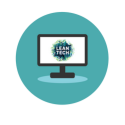
Very engaged and focused throughout the course. Sticking to the agenda. Nice and pleasant.
In-person: Courses with physical attendance. Practical exercises and instructor guidance.
Virtual: Courses via Teams or similar. Practical exercises and instructor guidance.
Online: Flexible digital learning. Start anytime and access for 1 year. Includes certificate.
You can choose Lean Six Sigma belt courses, or a topic in problem solving and improvement that you want to learn more about.
Filter by theme and course format:
You learn the most basic about Lean Six Sigma and how to improve your own processes.
This includes setting clear goals, obtaining data and facts to uncover causal relationships, introduce simple, effective solutions that last.
You learn methods and tools to lead successful improvement projects and to become a good problem solver.
This includes to choose the right project, understand the problem, measure current situation, analyze, prove, and solve root causes to create lasting results.
You learn to use DMAIC to solve complex problems and lead improvement projects with cross-functional teams.
You learn to use data analysis and visualization for process improvement and product development, and guide others in improvement methods.
You learn methods and best practices to align an organization towards common goals, achieve operational control, and continuously improve.
Visual management contribute to improved process performance and sustainable gains.
You learn methods and structures that help you succeed with improvements.
This involves structures for operational control and continuous improvement, and the use of lean principles to improve flow.
Training for teams who wants to improve their own processes using the fact-based problem-solving method Lean Six Sigma.
We use DMAIC to solve a problem that is relevant to you. Topics and length depend on your needs.
You learn to identify, prove and solve true root causes to ensure lasting results.
The course follows Six Sigma's DMAIC, with main focus on Measure & Analyze phase.
You learn to use an A3 template to solve problems in 7 steps.
Start with the background, map the current situation, set a specific goal, analyze, prove & solve root causes, follow up for lasting results.
You learn to create a Value Stream Map (VSM) and improve flow using Lean principles.
We use a Lego game to practice VSM and improve the process between the two game rounds.
This Lean game illustrates challenges and opportunities of supply chains.
The effects of fluctuations in demand are experienced, and methods for more robust supply chains are evaluated.
You learn to focus on value-adding activities to achieve your goals.
This includes productivity tools and techniques to measure, evaluate, plan and improve your time management.
You learn to use Statistical Process Control - SPC to react properly to measurement results.
This includes use of control charts to separate normal and special cause variation, consider stability and capability.
You learn to use Statistical Process Control - SPC to react properly to measurement results.
This includes use of control charts to separate normal and special cause variation, consider stability and capability.
You learn to use Measurement System Analysis (MSA) to consider precision, accuracy, stability, sensitivity, and capability of your measurements.
Reliable measurements are necessary to make good decisions and improve.
You learn to develop hypothesis and to test if they are true or false (useful for understanding causal relationship).
This includes determining whether data sets have significant different centering and/or variation.
You learn design of experiment (DOE) to develop product and processes efficient and effective.
You reduce development costs and save time by testing multiple combinations at the same time.
You will learn to use the statistical software JMP to perform relevant analyses during your DMAIC project.
This includes describing datasets, assessing distribution, creating control charts, conducting MSA, performing regression analysis, hypothesis testing, DOE, and analyzing variation.
You learn how to improve your own processes:
Define clear goals, collect data and facts to uncover root causes, implement simple, effective solutions that create lasting results.
The training is delivered by partner GoLeanSixSigma.
You learn methods and tools to lead successful improvement projects using DMAIC, and to become a good problem solver.
The training is delivered by partner GoLeanSixSigma.
You learn advanced methods and tools to lead successful improvement programs and transform organizations.
This training enhances your leadership and statistical skills, making you a proficient problem solver and mentor.
Delivered by partner GoLeanSixSigma.
Lean Tech AS | Kristoffer Robins vei 13
0047 481 23 070
Oslo, Norway
L - Look for solutions
E – Enthusiastic
A – Analytical
N - Never give up


